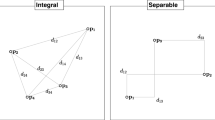Abstract
Multivariate models for the triangular and duo-trio methods are described in this paper. In both cases, the mathematical formulation of Euclidean models for these methods is derived and evaluated for the bivariate case using numerical quadrature. Theoretical results are compared with those obtained using Monte Carlo simulation which is validated by comparison with previously published theoretical results for univariate models of these methods. This work is discussed in light of its importance to the development of a new theory for multidimensional scaling in which the traditional assumption can be eliminated that proximity measures and perceptual distances are monotonically related.
Similar content being viewed by others
References
Amerine, M. A., Pangborn, R. M., & Roessler, E. B. (1965).Principles of sensory evaluation of food. New York: Academic Press.
David, H. A., & Trivedi, M. C. (1962). Pair, triangle and duo-trio tests (Technical Report 55). Blacksburg, VA: Virginia Polytechnic Institute, Department of Statistics.
Ennis, D. M., & Mullen, K. (1985). The effect of dimensionality on results from the triangular method.Chemical Senses, 10, 605–608.
Ennis, D. M., & Mullen, K. (1986a). A multivariate model for discrimination methods.Journal of Mathematical Psychology 30, 206–219.
Ennis, D. M., & Mullen, K. (1986b). Theoretical aspects of sensory discrimination.Chemical Senses, 11, 513–522.
IMSL (1984).IMSL Library (Version 9.2). Houston, TX: Author. (Developed by IMSL, Inc., 7500 Bellaire Blvd., Houston, TX 77036)
Frijters, J. E. R. (1979). Variations of the triangular method and the relationship of its unidimensional probabilisitic models to three-alternative forced choice signal detection theory models.British Journal of Mathematical and Statistical Psychology, 32, 229–241.
Frijters, J. E. R., Kooistra, A., & Vereijken, P. F. G. (1980). Tables ofd′ for the triangular method and the 3-AFC signal detection procedure.Perception and Psychophysics, 27(2), 176–178.
Kruskal, J. B. (1964a). Multidimensional scaling by optimizing goodness of fit to a nonmetric hypothesis.Psychometrika, 29, 1–27.
Kruskal, J. B. (1964b). Nonmetric multidimensional scaling: A numerical method.Psychometrika, 29, 115–129.
Shepard, R. N. (1962). The analysis of proximities: Multidimensional scaling with an unknown distance function. I, II.Psychometrika, 27, 125–140, 219–246.
Shepard, R. N. (1963). Analysis of proximities as a technique for the study of information processing in man.Human Factors, 5, 19–34.
Ura, S. (1960). Pair, triangle and duo-trio tests.Japanese Union of Scientists and Engineers, 7, 107–119.
Author information
Authors and Affiliations
Additional information
We thank J. Frijters, J. Tindall, H. A. David, R. Pangborn, and J. and E. Kapenga for useful discussions and criticism; M. Waugh, D. Zima, D. Paulson, and S. Osborne for computer support; and J. Day and Y. Lancaster for manuscript preparation assistance.
Rights and permissions
About this article
Cite this article
Mullen, K., Ennis, D.M. Mathematical formulation of multivariate euclidean models for discrimination methods. Psychometrika 52, 235–249 (1987). https://doi.org/10.1007/BF02294237
Received:
Revised:
Issue Date:
DOI: https://doi.org/10.1007/BF02294237




